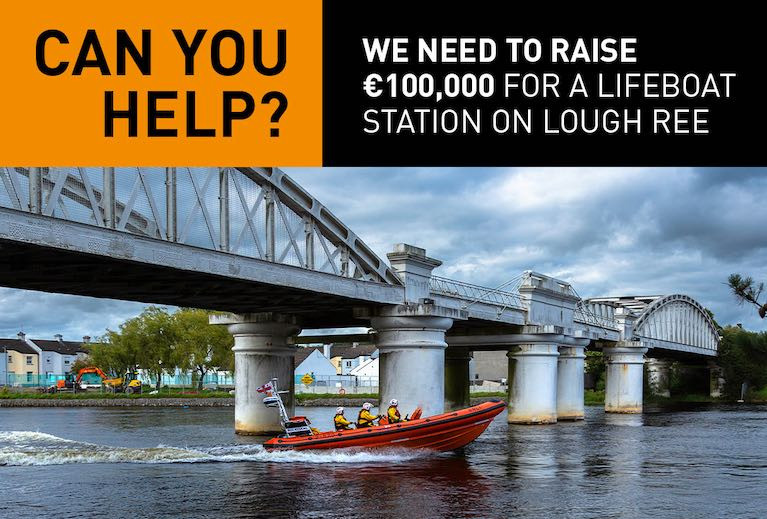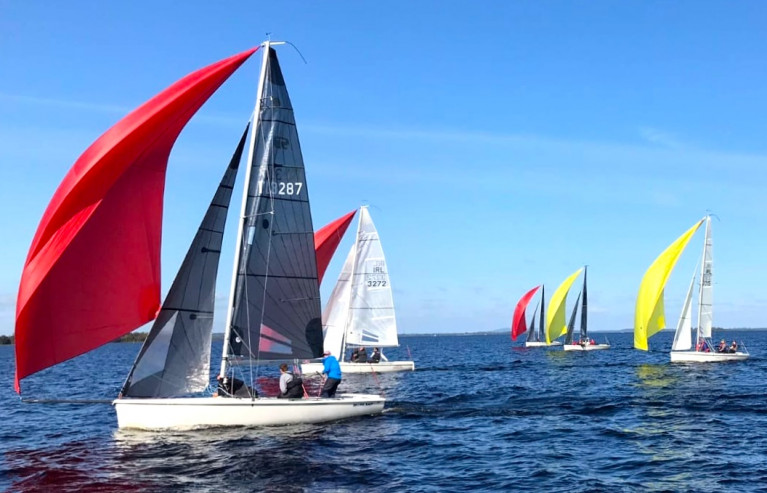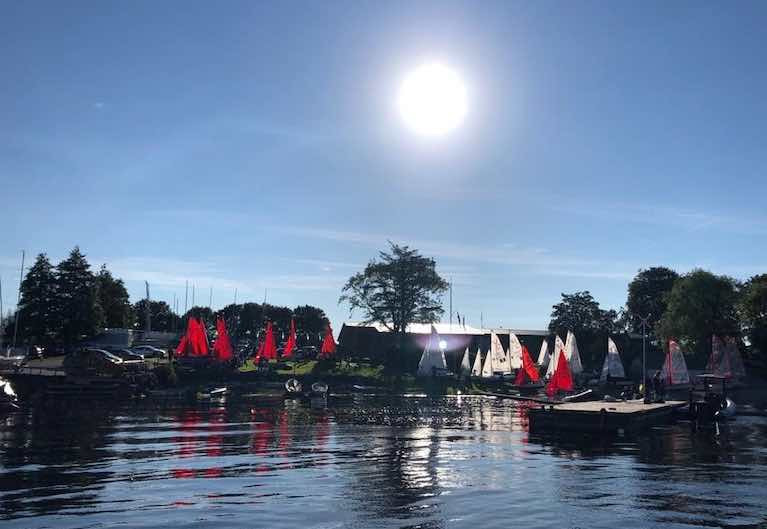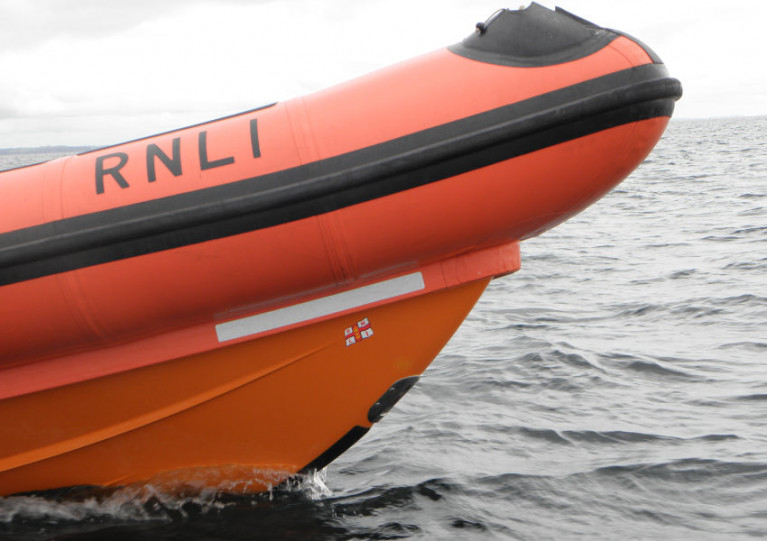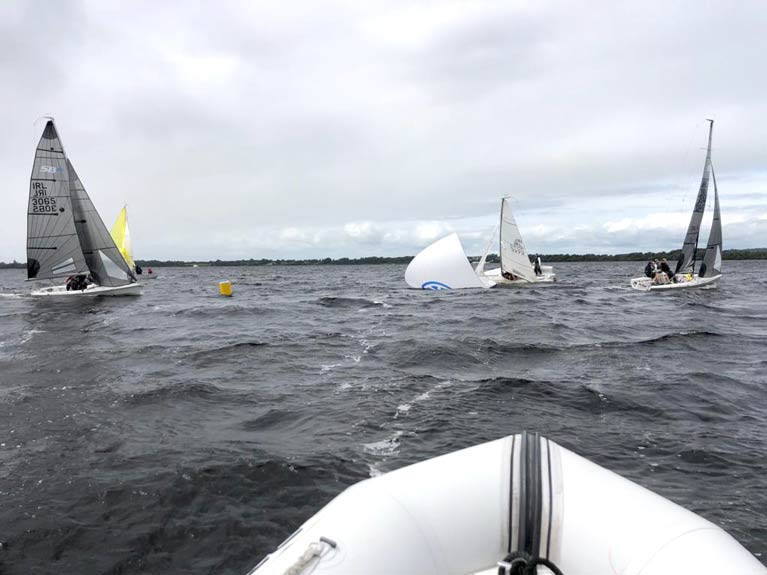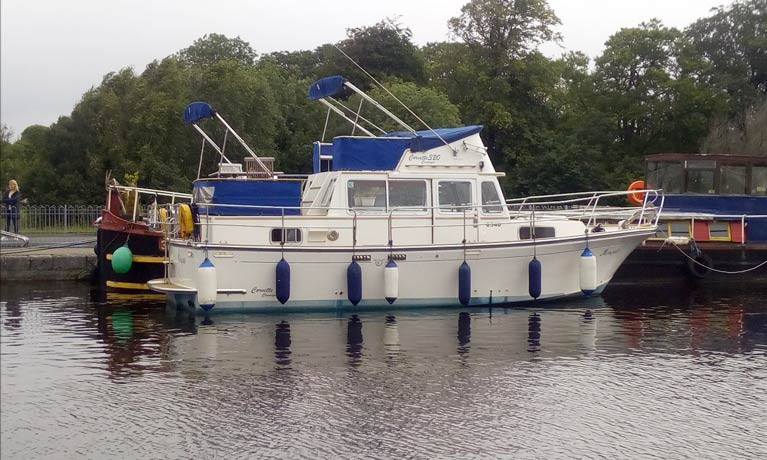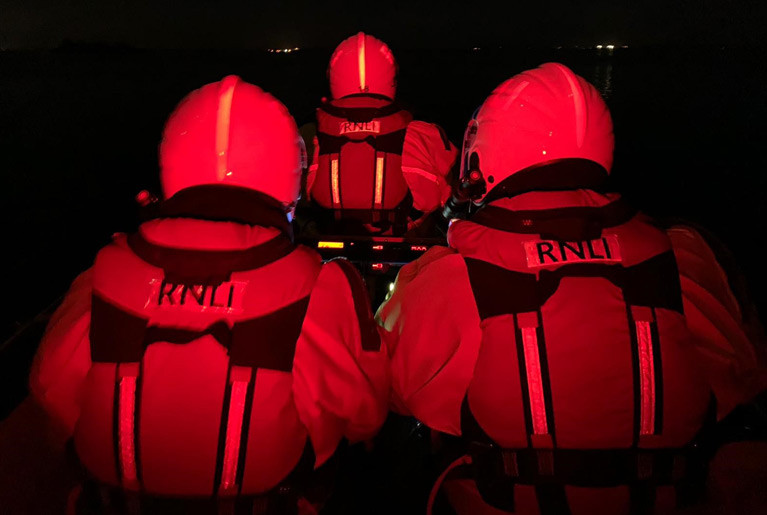Displaying items by tag: Lough Ree
Lough Ree RNLI Looking to Raise €100k for New Base at Coosan Point
Coosan Point on Lough Ree is home to one of Ireland’s busiest lifeboat crews. But they operate from temporary facilities and the RNLI say they urgently need a permanent, new base to continue their lifesaving missions.
The Institute is seeking donations to help fund a new, purpose-built lifeboat station and are aiming to raise €100k.
Lough Ree volunteer crews have been rescuing people from the lake’s 28km stretch of inland water since 2012, launching more than 370 times and helping over 1,060 people.
The permanent station near the existing slipway at Coosan Point – crucial for the efficient launching and recovery of the lifeboat will include
- Secure boathouse for lifeboat, launch tractor and trailer
- Crew training and meeting rooms
- Changing facilities, showers and WCs
- Offices and operations room
- Workshop and fuel storage facilities
Irish sailing Goes Beyond The Pale to Keep the Show on the Road
At midnight on Friday, the lockdown shutters came down on the million-plus inhabitants of a place that no longer exists. And no, we don't mean that Dublin has obviously become a ghost town. But what we do mean is that when the powers-that-be start firing off diktats as to what the people of County Dublin can or cannot do as regards socialising and travel, they're talking of a place that is at one with Nineveh and Tyre.
For County Dublin as an administrative area has long since been replaced by the fiercely independent Dukedoms of Dun Laoghaire-Rathedown and South Dublin, the Commune of Dublin City, and to the north by the Viking Fortress of Fingal, the Land of the Fair Strangers. Denmark West, in other words, where we're bygge on hygge.
 Lough Ree's racing was lively. Photo Mary Paul Mulligan
Lough Ree's racing was lively. Photo Mary Paul Mulligan
Doubtless m'learned friends will have a field day if legal actions are taken on the basis of prohibitions relating to this Dublin County place. But the rest of us know that, just as you should be wary of a car coming off the production line on a Friday afternoon, so you should be wary of the ultimate validity of official pronouncements made at that same time.
Thus the sailing community, being responsible citizens, cancelled the weekend's events left right and centre in the greater Dublin area. But way down the road on the lakes and wherever – the Land Beyond The Pale – they were indeed well beyond the Pale, as they continued to work in their suntans at Lough Ree Yacht Club, which gallantly manages to put a meaningful if very reduced programme together to comply with limitations while celebrating their Quarter Millennium with racing on Friday and Saturday, and then on Sunday the SB20s moved to Lough Derg YC for the first race of their Sunday Series.
 While Dublin went into paralysis, Race Officer Alan Algeo and Regatta Organiser Jonny Swann were working hard on their elbow bumps and suntans down Lough Ree way. Photo: John Malone
While Dublin went into paralysis, Race Officer Alan Algeo and Regatta Organiser Jonny Swann were working hard on their elbow bumps and suntans down Lough Ree way. Photo: John Malone
At Lough Ree, it was the Homecoming Regatta organised by Jonny Swan (that's the Swan of Classic Half Tonner Harmony when he's on salt water) with racing for SB20s, Shannon One Designs, and cruisers, with the pace being set by the SB20s.
They hope that this will lead on to a big-fleet SB20 Midlands at Lough Derg on 10th/11th, as our Midlands Messiah points out that the imprisonment of Dubliners – if the powers-that-be mean three weeks when they say three weeks – should actually end at 23.59 on 9th October.
Meanwhile on Sunday at Lough Ree, the SB20 racing was concluded with Eoin Leahy and Donie Heraghty on Strictly Business winning overall with 9 points to the 11 of Bango (Commodore John McGonigle & Kevin Fenton), which had been helmed by Cillian Dickson on the Saturday and young Ben Graf on the Sunday, with third slot on 14pts going to Ken Hudson of Arklow’s Serius Black helmed by Aidan Breen with third hand Niall Smythe.
 Conditions were so light on Sunday that racing an SB20 with just two was a possibility. Photo: Brian McElligott
Conditions were so light on Sunday that racing an SB20 with just two was a possibility. Photo: Brian McElligott
Tight Battles at 420 Dinghy Connaught Championships at Lough Ree Yacht Club
Following hot on the heels of the Irish 420 National Championships held in Dunmore East the Connaught Championships were held last weekend at Lough Ree Yacht Club as part of the clubs Double Ree regatta celebrating double-handed youth sailing. The adrenalin rush of the open seas and big waves was replaced with two contrasting days of excellent lake sailing. Home advantage lay with the Lough Ree Yacht Club crews who had claimed both the Gold and Silver fleet honours at the nationals with some dominant displays. But this event featured contrasting results to the National Championships where Graf/Farrell previously had such a dominant display, Lough Ree, in contrast, produced five different race winners across the six-race starts.
 2020 Connaught Championships - Winners of Gold Fleet - Jack McDowell of Malahide Yacht Club and Harry Thompson of Wexford Harbour Sailing Club
2020 Connaught Championships - Winners of Gold Fleet - Jack McDowell of Malahide Yacht Club and Harry Thompson of Wexford Harbour Sailing Club
 2nd place Gold Fleet - Ben Graf and Alexander Farrell of Lough Ree Yacht Club
2nd place Gold Fleet - Ben Graf and Alexander Farrell of Lough Ree Yacht Club
 3rd place Gold Fleet - Harry Shackelton and Cara McDowell of Malahide Yacht Club
3rd place Gold Fleet - Harry Shackelton and Cara McDowell of Malahide Yacht Club
Saturday delivered a moderate breeze with winds strength ranging from the low teens into the low twenties blowing down the length of the lake from the north. The choppy lake waves provided a new challenge in contrast to the rollers at Dunmore east the previous week. The Race Officer David Dickson was able to run three excellent races before calling a halt to proceedings with Graf/Farrell holding a one-point lead over Rickard/Pank who held a further two-point lead over McDowell/Thompson in third. Each crew had one race win with the leader board looking like a game of snakes and ladders through the day, but Graf/Alexander were the more consistent crew on the day allowing them to hold the overnight lead.
Sunday dawned with clear blue skies and not a breath of wind as the sailors prepared for an early start. A light lake breeze soon settled in time for racing to commence. The light shifty breeze give the sailors plenty to think and the first race on day two went to McDowell/Thompson parachuting them into the lead temporarily. The next two races say two new race winners with race five won by a country mile by Leech/Paul and race six won by Shackelton/McDowell. Leader positions in both fleets changed frequently but the more consistent performance of Graf/Farrell and McDowell/Thompson saw both crews etch out a small advantage over the rest of the fleet. The pair were separated by half a boat length at the finish of race five handing the advantage to the Graf/Farrell crew heading into the last race. Shackelton/McDowell took the early lead of race 6 with Graf/Farrell tucked in with the leading boats and McDowell/Thompson trailing in 7th place. Steady improvements up the fleet during the race say McDowell/Thompson reach the top of the final beat just behind Graf/Farrell who had the misfortune to get a twist in their spinnaker in the reach across the top of the trapezoid course. With the spinnaker problems ironed out a game of cat and mouse began down the final leg towards the leeward mark before the final turn for home and a reach to the finish where the winners crossed the finish line a sweaty palm one boat length ahead of the Graf/Farrell team. The winning crew of McDowell/Thompson got the title on a tie break with a score of 10pts. Positions three to five were separated by only one point with Shackelton/McDowell in third on 16pts and Richard/Pank plus Leech/Paul both on 17pts.
The podium for the silver fleet saw new names stepping up to take first and third-place positions. McMullan/Smyth took the title with McGrady/O’Sullivan in third and second place again going to Hauer/Micka as they did in the nationals the previous week.
 Winners of Silver Fleet - Sam McMullan and Daniel Smyth of Lough Ree Yacht Club
Winners of Silver Fleet - Sam McMullan and Daniel Smyth of Lough Ree Yacht Club
 2nd place Silver Fleet - Imogen Hauer and Hugo Micka of Malahide Yacht Club
2nd place Silver Fleet - Imogen Hauer and Hugo Micka of Malahide Yacht Club
 3rd place Silver Fleet - Adam McGrady and Aly O'Sullivan of Galway Bay Sailing Club
3rd place Silver Fleet - Adam McGrady and Aly O'Sullivan of Galway Bay Sailing Club
Gold fleet
1st Place Gold Fleet – Jack McDowell, Malahide Yacht Club & Harry Thompson, Wexford Harbour Boat and Tennis Club.
2nd Place Gold Fleet – Ben Graf & Alexander Farrell, Lough Ree Yacht Club
3rd Place Gold Fleet– Harry Shackelton and Cara McDowell, Malahide Yacht Club
Silver fleet
1st Place Silver Fleet – Sam McMullan & Daniel Smyth, Lough Ree Yacht Club
2nd Place Silver Fleet – Imogen Hauer & Hugo Micka, Malahide Yacht Club
3rd Place Silver Fleet – Adam McGrady & Ally O’Sullivan, Galway Bay Sailing Club
Lough Ree RNLI Launches Fundraising Drive For New Lifeboat Station
One of Ireland’s busiest lifeboat units is seeking the public’s help to upgrade its home base and carry on its lifesaving mission.
Lough Ree RNLI’s volunteers have been rescuing people from the lough’s 29km stretch of inland waterway since 2012, launching more than 370 times and helping over 1,060 people.
But despite their key role in water safety for the area, their lifeboat station operates from temporary shipping containers — and the unit urgently needs a new, purpose-built station with modern facilities for casualties, crew and craft.
“A new lifeboat station will make a huge difference to our lifesaving service here and in the local community,” said crew member Tom Bradbury.
“It will provide excellent training and changing facilities, and help us launch safety and efficiently every time. With you by our side, we can carry on our rescue mission.”
The crew are counting on public generosity to help them raise €100,000 towards cost of this new building at Coosan Point, which would be shared with the Inland Waterways Association of Ireland (IWAI).
And any funds raise above the €100,000 target will be used across all RNLI services, wherever they’re needed most.
Click HERE to donate to the Lough Ree lifeboat appeal. If you have any questions about the appeal, or would prefer to donate by phone, call the RNLI supporter experience team at 81 895 1877 (or 0300 300 9907 if calling from the UK) weekdays from 8am to 6pm.
Youghal Lifeboat Launches To Kayaking Siblings In Difficulty
Youghal RNLI’s volunteer crew were paged Friday evening (14 August) to reports of two kayakers in difficulty — with one thought to be in the water on the northern side of Capel Island.
On arrival, the inshore lifeboat confirmed that one person was in the water and the other was on the rocks of the East Cork island.
The man and the woman were quickly bought on board the lifeboat where the crew made sure both were unharmed before taking them to shore at Knockadoon Pier and the waiting coastguard team. No medical assistance was needed.
Speaking after the callout, deputy launching authority Mark Nolan said: “Kayaking is the most popular watersport in Ireland.
“We would advise people to check the weather and tides before going out, to always wear a buoyancy aid, carry a form of communication with you — and one easy and simple task is to always inform someone on shore of your departure time and estimated time of return.”
Elsewhere this past week, Lough Ree RNLI responded to three callout in two hours on Wednesday (12 August), helping to bring six people to safety.
The first call was just after noon, to assist three people whose motorboat had run aground on the Hexagon Shoal.
Less than an hour later, just as the crew recovered the inshore lifeboat Tara Scougall, they were requested to assist a person whose motorboat had got stuck on the weir boom in Athlone town.
And the final callout at 2.18pm was to two people onboard a boat that was taking on water in Lanesborough.
Lough Ree to Showcase Double-handed Youth Sailing with 'Double Ree' Regatta This Month
Lough Ree Yacht Commodore John McGonigle on his plans for this month's 'Double Ree' youth sailing regatta at the end of August to showcase double-handed dinghy racing
The first edition of Double Ree was held in Lough Ree Yacht Club in 2018. The concept was to bring the main double-handed youth classes together in order that they could run one of their respective regional championships at the same venue. It was intended to highlight the benefits and fun of double-handed sailing and to showcase an alternative to the usual route of single-handed sailing.
This year, Double Ree was intended to form part of Lough Ree Yacht Club's 250th-anniversary celebrations. It had originally been scheduled for the weekend of the 18th– 19th of July. Then COVID 19 came along and the event was postponed.
It has now been rescheduled for the weekend of the 29th and 30th of this month.
The Mirror Northern Championship, 420 Connacht Championship and 29er Western Championship will all be decided on Lough Ree. While it's fantastic to be able to restore the event, we had to limit numbers in order to comply with the 200 person limit as dictated by the HSE and Irish Sailing. A host of measures have been put in place to ensure social distancing, sanitizing and contact tracing in order to keep everyone as safe as possible.
These measures have been well tried and tested at our annual regatta last week.
Lough Ree Yacht Club has invested a lot of effort into double-handed sailing. As in most clubs, our sailors generally start in Optimists. We quickly encourage them to try crewing in Mirrors while still developing their skills in the Optimist. Mirrors are particularly suited to very young crew as they do not have to manage the hoists and drops of the spinnaker. The helm does that. They absorb experience from the older more experienced helms and get to experience conditions that might be a bit too much for them were they in a single-handed boat.
As they grow older and develop their skills they moved to the back of the boat as a helm.
It's not unusual for a sailor to sail in a Mirror from age 9 to 15.
The 420 is the Lough Ree YC's choice of boat for the next step. It's a natural progression from a Mirror, where our sailors get to expand their skills with the addition of a trapeze and a highly tuneable rig.
Once the challenge of pairing crew and helm is overcome, it's a lot more friendly than single-handed sailing. This is very appealing for many.
Our main focus with youth sailors is to develop skills and to keep them in sailing for as long as we can.
We have found that if we can attract sailors into competitive double-handed sailing, they will generally keep sailing until their college years.
Double Ree is a fantastic opportunity to showcase double-handed sailing and for sailors to see other classes in action, as all the classes will be raced in the same location.
We hope that that the various fleets will come to appreciate the merits of each other's fleets.
Camping and mooring facilities are available at the club. There will be food available on Friday and Saturday evenings.
Registration will be open on Monday here
Go Algeo! Lough Ree’s Water-Skiing Former Commodore Keeps up Appearances on Lough Derg
Once a Commodore, always a Commodore. And though it’s quite some time since Alan Algeo was Commodore of Lough Ree Yacht Club, in this its Quarter Millennium Year he feels that the frustrations of the COVID-denial of the full celebrations makes it more incumbent than ever upon everyone to keep up appearances, particularly when performing special ambassadorial duties on other waterways.
So when he was challenged the other day to a spot of water-skiing just down the road on Lough Derg, while he did abandon the reefer jacket in order to accommodate the lifejacket in more comfort, there was no way he was going to be seen in a semi-public setting without his club tie. And in a week when every other part of the country seems to have been under a perma-cover of grey near-fog, or smothered in full cloud burst downbursts, or worse still knocked out by mighty thunderstorms, Lough Derg was most appropriately looking particularly beautiful with the Tipperary Riviera along by Kilgarvan at its luscious best as the Algeo acceleration took off in style.
SB20 'Slippery Nipple' Takes Lough Ree 250 Regatta
The overall winner of the Lough Ree 250 SB20 event was John Malone and Emmet Sheridan's 'Slippery Nipple' 3040, with Patrick Whyte as bowman.
There were race wins for five SB20s in the eight-race 250 Regatta to celebrate 250 years of the River Shannon club.
Eoin Leahy, Donie Hearaghty and Luke Johnson won the Andrew Mannion Trophy for race one.
 Husband & Wife Team Liz & Martin MacNamara on-board Jude Kilmartin's Sharkbait took line Honours in race six to win the Lifeboat plate.
Husband & Wife Team Liz & Martin MacNamara on-board Jude Kilmartin's Sharkbait took line Honours in race six to win the Lifeboat plate.
Racing continues this week with a lay day Tuesday.
 Lough Ree Yacht Club Race Officer Alex Hobbs
Lough Ree Yacht Club Race Officer Alex Hobbs
The regatta is warm-up for the first SB20 Regional event of 2020 will be hosted by RStGYC this coming weekend 8/9 August on Dublin Bay.

Royal Ulster Yacht Club members John and Sally McKee played a crucial part in their motor cruiser in a dramatic incident on the Shannon waterway last Saturday.
A private cruiser from Limerick was making a passage northwards on Lough Ree but due to a navigational error ran aground on rocks in Cruit Bay, now known as Portrunny, on the western shore of the Lough. Onboard were two adults and three children and the boat suffered serious hull damage.
The Lifeboat was launched within 10 minutes and on station in 30 minutes. By then the children had been transferred to the cruiser's punt, along with the mother of two of the children and an aunt to the third. All were very wet and cold. The McKee's Mosquito offered assistance and stood by the casualty at a safe distance. The lady and children were taken on board Mosquito where Sally and John provided reassurance to the distressed Mum and children along with hot drinks, dry towels and a warm cabin. The Skipper remained on board the stricken vessel in an attempt to save it but eventually took the instructions from the RNLI coxswain and evacuated onto the lifeboat.
The nearest harbour was Portrunny where ‘Mosquito’ safely docked an hour later, keeping the crew onboard until transport was arranged back to Limerick.
Lough Ree lifeboat Operations Manager Tony McCarth said: "The vessel was badly damaged and the salvage pump put onboard was overwhelmed, there was no option other than abandoning the cruiser. The decision to put the mother and children aboard Mosquito was entirely rational as it would have been a very wet cold journey for them in an open RIB".
This was one of two callouts for Lough Ree RNLI who helped a total seven people to safety. The callouts were both to grounded cruisers and gave the lifeboat crew only nine minutes rest between them. The first was to help two people onboard a 27ft cruiser which had run aground near a navigation marker and the second was the incident in which Mosquito was involved.
Lough Ree RNLI brought a drifting motor cruiser to safety on Saturday night.
At 9.35 pm on Saturday, (4 July) Lough Ree RNLI volunteers were requested by Malin Head Coast Guard to reports of a motor cruiser adrift near Portrunny Harbour on the north-west shore of Lough Ree.
The casualty vessel had broken its moorings and drifted out of the harbour with no one on board.
The inshore lifeboat Tara Scougall and her crew quickly found the casualty vessel and brought the boat safely back to the harbour and tied her up before making their return to the lifeboat station at Coosan Point.
Speaking after the call out, Lough Ree RNLI Helm Kieran Sloyan said: ‘Conditions on the lake were very rough with a strong westerly wind. We would like to remind all boat owners to regularly check their mooring lines to ensure their boat is suitably secured. If you do see a boat adrift, please call 999/112 and ask for the Coast Guard.’




























